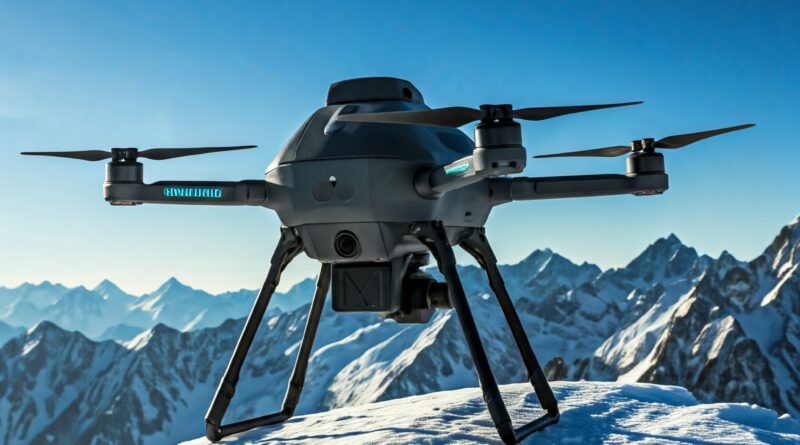Durable Drones for Extreme Conditions
Durable Drones for Extreme Conditions: An Essential Guide
The drone industry has witnessed remarkable growth over the past decade, with applications spanning from recreational use to complex industrial tasks. Among the various types of drones, those designed for extreme conditions stand out for their engineering prowess and adaptability. Whether it’s conducting research in harsh environments or performing critical missions in disaster zones, durable drones are indispensable. This article delves into the world of durable drones, exploring their features, applications, and the latest innovations designed to withstand the most challenging environments.
Understanding Durable Drones
Durable drones are designedto operate in extreme conditions that would typically incapacitate standard drones. These conditions can include extreme temperatures, high winds, heavy rainfall, saltwater exposure, and even high-altitude operations. The demand for such drones is on the rise, driven by industries such as military, scientific research, and emergency services.
Key Features of Durable Drones
What sets durable drones apart from their everyday counterparts? Here are some of the key features that ensure their resilience:
Weatherproof Design
Weatherproofing is a crucialfeature for drones operating in extreme conditions. These drones often have sealed components to prevent water and dust ingress, allowing them to function in rain, snow, or desert environments. For instance, the DJI Matrice 300 RTK is known for its IP45 rating, which offers substantial protection against water and dust.
Temperature Resistance
Temperature fluctuations can severely affect drone performance. Durable drones are equipped with temperature-resistant electronics and materials that allow them to operate efficiently in both sub-zeroand high-temperature environments. The Parrot Anafi USA, for example, can operate in temperatures ranging from -32°C to 43°C.
Robust Materials
Durable drones are often constructed with high-strength materials like carbon fiber and aerospace-grade aluminum, which provide the necessary strength without adding excessive weight. The Autel Robotics EVO II is a prime example, featuring a rugged body designed to withstand impacts and harsh operational conditions.
Advanced Navigation Systems
Extreme environments often come with challenges such as limited visibility and GPS signal interference. Drones like the Skydio X2 utilize advanced navigation systems that incorporate AI-based obstacle avoidance and visual-inertial odometry, ensuring reliable navigation even when traditional systems fail.
Applications of Durable Drones in Extreme Conditions
Durable drones have a wide range of applications across various industries. Here are some notable examples:
Military and Surveillance
Drones are extensively used in military operations for reconnaissance and surveillance in harsh terrains and weather conditions. Their ability to operate in areas where traditional vehicles cannot reach provides a tactical advantage.
Environmental and Scientific Research
In environmental research, drones help scientists gather data from remote or inaccessible locations. Durable drones are used in polar regions to study ice formations and in volcanic areas to monitor eruptions without endangering human lives.
Disaster Response and Recovery
During natural disasters, drones play a critical role in assessing damage and locating survivors. Their ability to quickly deploy and navigate through debris-laden areas makes them invaluable tools for emergency services.
Industrial Inspections
Industries such as oil and gas, power generation, and construction use drones for inspections in hazardous environments. Durable drones can access hard-to-reach areas, capturing high-resolution images and videos that aid in maintenance and repair activities.
Emerging Technologies in Durable Drones
The evolution of drone technology continues to push the boundaries of what these machines can accomplish. Here are some emerging technologies making durable drones even more formidable:
AI and Machine Learning
Artificial Intelligence (AI) and machine learning are transforming how drones interpret and respond to their environments. By analyzing data in real-time, drones can make autonomous decisions, enhancing their ability to navigate complex terrains.
Improved Battery Technology
Battery life is a critical factor for drone operations. Recent advancements in battery technology are extending flight times, allowing drones to cover greater distances and perform longer missions without needing frequent recharges.
Enhanced Sensor Capabilities
Sensors such as LiDAR, thermal cameras, and multispectral imaging are becoming more sophisticated, providing drones with enhanced data collection and analysis capabilities. These sensors allow for detailed environmental mapping and monitoring.
Modular Designs
Modular designs are becoming popular in durable drones, allowing operators to customize payloads based on specific mission requirements. This flexibility ensures that a single drone can serve multiple purposes across different industries.
Choosing the Right Durable Drone
With the plethora of options available, selecting the right durable drone can be challenging. Here are some tips to guide your decision:
Assess Your Needs
Determine the specific conditions and applications for which you’ll be using the drone. Consider factors such as weather, terrain, and the nature of the tasks to be performed.
Evaluate Features and Specifications
Compare different models based on features such as flight time, payload capacity, and sensor types. Ensure that the drone’s specifications align with your operational requirements.
Consider Manufacturer Support
Choose a manufacturer known for reliable customer support and after-sales service. This is particularly important when operating in extreme conditions where technical issues can arise.
Budget Considerations
Durable drones can be a significant investment. Consider your budget and weigh the cost against the drone’s capabilities and the value it will bring to your operations.
Conclusion
The development of durable drones is revolutionizing operations in extreme conditions, offering unprecedented capabilities and reliability. As technology continues to advance, these drones are set to become even more integral to industries requiring robust and adaptable solutions. Whether you’re involved in military operations, scientific research, or disaster response, investing in durable drones can significantly enhance your operational efficiency and effectiveness.
By understanding the features, applications, and emerging technologies of durable drones, you can make informed decisions to harness their full potential. As the drone industry evolves, staying updated with the latest advancements will ensure that you remain at the forefront of this dynamic field.

